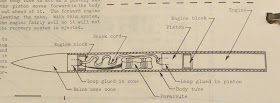From the Estes Model Rocket News, Vol.3, #1, February/March, 1963
Here's an early piston ejection drawing making wadding or parachute protectors unnecessary.
A solid nose block is slid down and rests against the engine block. The nose block is attached to a shock cord and to the nose cone.
Note the engine block recessed down from the top of the body tube. it is glued in place and stops the travel of the piston. That upper engine block could block passage of the parachute.
The instructions say to securely friction fit the engine so it doesn't eject. Where is the ejection charge supposed to go or vent?
It's still a great idea and used in some MPR kits.


I would guess that the ejection charge ends up venting out the nozzle end (provided it doesn't get clogged with debris). As such, there probably will be increased concern with the inside getting "cooked" (aka "hibachi effect") because it'll take longer for the hot gasses to vent (than if you've got an open tube or with vent holes).
ReplyDeleteHi Naoto,
DeleteThat's a lot of ejection gas pressure to go out the nozzle! I bet a body tube right above the engine wouldn't last through too many launches.
Yeah, not crazy about that upper engine block setup. It seems to me that the parachute or shock cord could get caught between the block & piston and either get damaged or not allow the parachute to fully eject. It might be better to eliminate the upper block and allow the piston to eject all the way out of the body tube, kinda like a cork gun. The piston would have to be tied to the engine mount with a Kevlar line.
ReplyDeleteI agree Lonnie!
DeleteThat's the way Public Missiles does it. I just thought it was interesting that someone came up with this in 1963.
This is great stuff guys. I am getting back into rocketry. I'm an avid(obsessed) rc aircraft guy.
ReplyDeleteIs there any other good recovery mechanisms sans ejection charge that I can take a look at?
Hi Rob,
DeleteI don't quite understand the question - It might be best to post this question at: www.therocketryforum.com